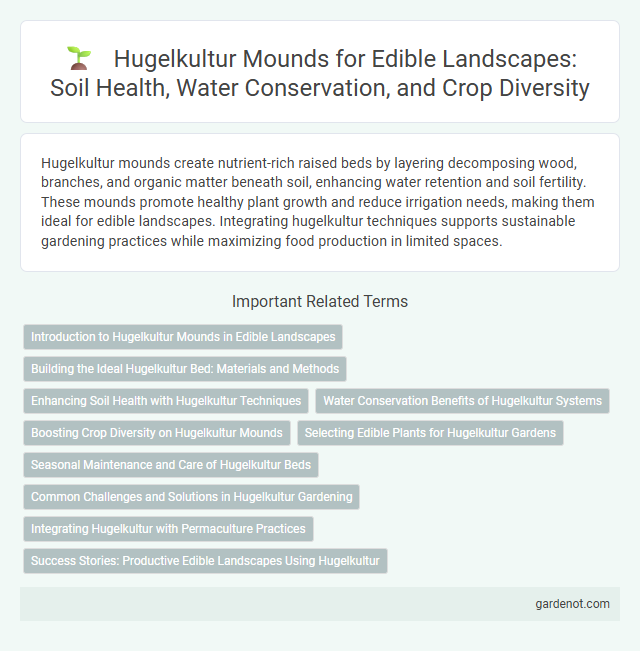Hugelkultur mounds create nutrient-rich raised beds by layering decomposing wood, branches, and organic matter beneath soil, enhancing water retention and soil fertility. These mounds promote healthy plant growth and reduce irrigation needs, making them ideal for edible landscapes. Integrating hugelkultur techniques supports sustainable gardening practices while maximizing food production in limited spaces.
Introduction to Hugelkultur Mounds in Edible Landscapes
Hugelkultur mounds are raised garden beds created by layering decaying wood, branches, and organic materials, enhancing soil fertility and water retention in edible landscapes. These mounds support diverse plant growth by improving nutrient cycling and moisture regulation, making them ideal for fruit trees, vegetables, and herbs. By mimicking natural forest processes, Hugelkultur integrates sustainable permaculture principles into productive food gardens.
Building the Ideal Hugelkultur Bed: Materials and Methods
Constructing the ideal hugelkultur bed involves layering decomposing wood, branches, and organic matter to create a nutrient-rich, moisture-retentive mound. Select hardwood logs for the base, ensuring slow decomposition, and top with compost, garden soil, and mulch to support diverse plant growth. Proper orientation and layering optimize aeration and water retention, establishing a sustainable edible landscape foundation.
Enhancing Soil Health with Hugelkultur Techniques
Hugelkultur mounds enhance soil health by creating a rich, organic environment that improves moisture retention and nutrient availability. Decomposing wood at the core of the mound boosts microbial activity, fostering a fertile ecosystem beneficial for plant growth. This technique reduces the need for irrigation and synthetic fertilizers, promoting sustainable and resilient edible landscapes.
Water Conservation Benefits of Hugelkultur Systems
Hugelkultur mounds enhance water conservation by efficiently retaining moisture through decomposing wood, which acts like a sponge, reducing the need for frequent irrigation in edible landscapes. The porous structure improves soil aeration and encourages beneficial microbial activity, promoting healthy plant growth even in drought-prone areas. This sustainable technique maximizes water use efficiency and supports resilient garden ecosystems by minimizing runoff and evaporation.
Boosting Crop Diversity on Hugelkultur Mounds
Hugelkultur mounds enhance crop diversity by creating nutrient-rich, well-draining soil profiles that support various plant species. Decomposing wood within the mound retains moisture and releases essential nutrients gradually, fostering a thriving ecosystem for vegetables, herbs, and perennials. This microhabitat encourages symbiotic relationships and increases resilience against pests and drought, optimizing edible landscape yields.
Selecting Edible Plants for Hugelkultur Gardens
Choosing edible plants for hugelkultur mounds involves selecting species that thrive in well-drained, nutrient-rich, and moisture-retentive soil created by decomposing wood. Perennials like berry bushes, rhubarb, and asparagus excel in these conditions, while fast-growing herbs such as chives and mint complement the microclimate. Incorporating nitrogen-fixing plants like clover or beans enhances soil fertility and supports sustainable growth within the hugelkultur garden.
Seasonal Maintenance and Care of Hugelkultur Beds
Hugelkultur beds require seasonal maintenance, including the addition of organic mulch and compost to replenish nutrients during spring and fall. Regularly monitoring moisture levels helps prevent drying out, especially in summer months, ensuring consistent plant growth. Removing invasive weeds and pruning overgrown plants promotes healthy airflow and maximizes the edible landscape yield throughout the year.
Common Challenges and Solutions in Hugelkultur Gardening
Hugelkultur mounds often face challenges such as initial nitrogen depletion, slow decomposition rates, and moisture retention issues. To address nitrogen depletion, gardeners commonly add nitrogen-rich materials like manure or compost during construction. Proper layering with varying wood sizes and incorporating a thick mulch layer improve decomposition and moisture balance, ensuring a productive edible landscape.
Integrating Hugelkultur with Permaculture Practices
Hugelkultur mounds enhance permaculture systems by improving soil fertility through decomposing wood materials that retain moisture and release nutrients over time. Integrating Hugelkultur with permaculture practices supports diverse plant growth by creating microclimates and reducing the need for irrigation. This synergy promotes sustainable food production and ecosystem resilience in edible landscapes.
Success Stories: Productive Edible Landscapes Using Hugelkultur
Hugelkultur mounds have transformed food production by enhancing soil fertility and moisture retention, resulting in bountiful yields of fruits, vegetables, and herbs. Numerous success stories highlight urban and rural gardens where hugelkultur beds sustain edible landscapes with minimal irrigation and input. These productive ecosystems demonstrate the technique's potential for sustainable, resilient food forests that thrive over multiple seasons.
Hugelkultur mound Infographic

 gardenot.com
gardenot.com